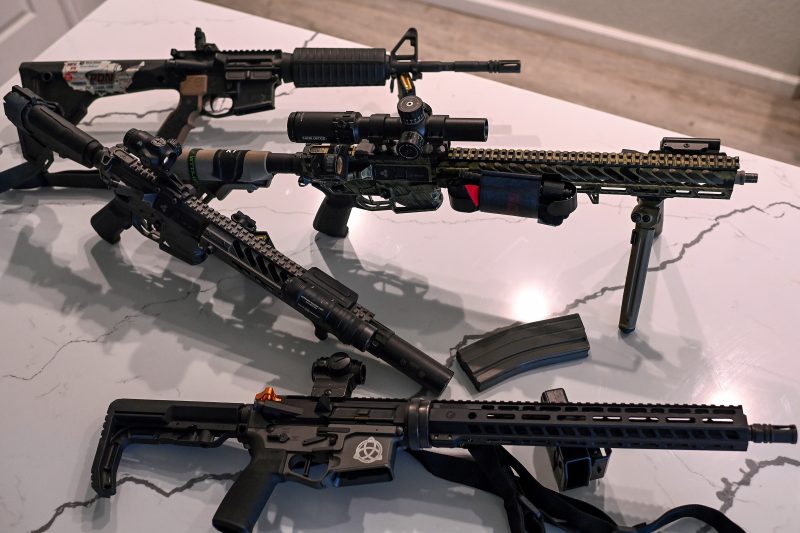Maryland can ban assault-style weapons such as the AR-15, a federal appeals court ruled Tuesday, bolstering gun control efforts across the country under legal threat.
The majority ruling from the U.S. Court of Appeals for the 4th Circuit written by Judge J. Harvie Wilkinson III, was joined by eight judges, with seven others penning a concurring opinion. Wilkinson repeatedly cited the landmark 2008 case of District of Columbia v. Heller, in which the Supreme Court upheld a Second Amendment right to possess a firearm at home for self-defense. That ruling also held that the Second Amendment does not guarantee “a right to keep and carry any weapon whatsoever in any manner whatsoever and for whatever purpose” and weapons with firepower far exceeding the needs of self-defense “may be banned.”
After dissecting how high-powered assault rifles are ineffective and inappropriate for self-defense, and recounting in some detail the horrors of mass shootings in the United States, the court endorsed the Maryland law by saying, “Our nation has a strong tradition of regulating excessively dangerous weapons once it becomes clear that they are exacting an inordinate toll on public safety and societal wellbeing.”
The ruling is an expected but welcome victory for gun regulation advocates, who are fighting hundreds of lawsuits spurred by a 2022 U.S. Supreme Court ruling that said such restrictions must be in line with the country’s “history and tradition.”
That high court decision dramatically expanded the reach of the Second Amendment, saying no public safety interest can justify novel restrictions on the right to bear arms. Only “dangerous and unusual” arms can be banned the Supreme Court said. But the justices have, for now, chosen not to intervene when federal courts have upheld bans on powerful and popular semiautomatic weapons.
Maryland’s policy was implemented in the wake of the 2013 Sandy Hook massacre, when an AR-15 was used to kill 20 children and six adults at a Connecticut elementary school.
The parties who challenged the Maryland law, including three gun rights organizations, said they would challenge Tuesday’s ruling. Adam Kraut, executive director of the Second Amendment Foundation, said “the court’s analysis is flawed and that the challenged law is unconstitutional. We will be filing a petition for certiorari at the Supreme Court, as this case presents an excellent vehicle for the Court to settle this debate once and for all.”
The dissent was written by Judge Julius N. Richardson and joined by four others.
“The Second Amendment is not a second-class right subject to the whimsical discretion of federal judges,” Richardson wrote. “Its mandate is absolute and, applied here, unequivocal.”
Richardson noted that “while history and tradition support the banning of weapons that are both dangerous and unusual, Maryland’s ban cannot pass constitutional muster as it prohibits the possession of arms commonly possessed by law-abiding citizens for lawful purposes.”
Wilkinson, a Ronald Reagan appointee once considered for the Supreme Court, said in oral arguments that states should have leeway in dealing with such weapons. He said he was particularly disturbed by the idea of the AR-15 as beyond regulation, given his experience with the similar M16 automatic rifle in the U.S. Army.
But other conservative judges on the court countered that the AR-15 is in such common use now that it cannot possibly be considered “unusual” enough to be banned.
Wilkinson’s opinion attacked that argument, saying that the Supreme Court ruling which reopened the Maryland case implied that a weapon must be “in common use today for self-defense” to be covered by the Second Amendment, focusing on the choice of the word “use” rather than “possession” of a weapon. The opinion noted that bans on machine guns, short-barreled shotguns and poison-firing guns have been upheld, and that an analysis of “common use … leads to absurd consequences because it totally detaches the Second Amendment’s right to keep and bear arms from its purpose of individual self-defense.”
The majority ruling also tracked the evolution of the killing power of guns in the United States, from imprecise and infrequently used for homicides in 1776 to the first mass slaying of 10 people in 1949. The military’s call for increased firepower during both world wars led to the development of more efficient deadly weapons. Those guns, such as the AR-15, then moved to the civilian population, and “it took only 32 seconds for a lone shooter to murder nine people and shoot 17 others in Dayton, Ohio,” in 2019, Wilkinson wrote. The shootings of Sandy Hook, Virginia Tech, Orlando and many others are also cited as examples of the AR-15′s overwhelming lethality.
Both Congress and state legislatures have responded to the dangers posed by semiautomatic weapons, with California restricting possession of assault weapons in 1989 and Congress enacting a 10-year ban on such weapons in 1994. “Throughout this history,” Wilkinson wrote, “lies a strong tradition of regulating those weapons that were invented for offensive purposes and were ultimately proven to pose exceptional dangers to innocent civilians … The Maryland statute at issue is yet another chapter in this chronicle.”
“To disregard,” Wilkinson concluded, “this tradition today — when mass slaughters multiply and the innovation of weaponry proceeds apace — could imperil both the perception and reality of well-being in our nation … The Second Amendment … does not require courts to turn their backs to democratic cries — to pile hopelessness on top of grief.”



























